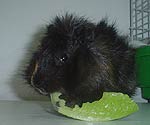 From first glance, it may appear as though guinea pigs may only have two sets of teeth: one at the top, and one at the bottom. In fact, guinea pigs have a total of twenty teeth, which consist of upper and lower premolars, and three pairs of lower and upper molars, along with the large, identifiable incisors.
From first glance, it may appear as though guinea pigs may only have two sets of teeth: one at the top, and one at the bottom. In fact, guinea pigs have a total of twenty teeth, which consist of upper and lower premolars, and three pairs of lower and upper molars, along with the large, identifiable incisors.
Guinea pig teeth are open-rooted, meaning that they grow continuously their entire lives, which is why itís vitally important that they always have something to chew on, such as hay.
Their incisors are extremely sharp, and they can chew through a variety of objects, such as wires and fabric, so itís best to keep them in a safe home with enough food and plenty of toys to keep them from becoming too destructive.
Checking Healthy Teeth
A guinea pig relies on their teeth for their survival, and maintaining healthy teeth is extremely important. They have very long incisors, which grow to about 1.5 centimetres long. If anything is wrong with their teeth, it will be obvious from their body language.
They may lose their appetite due to a sore tooth, or they may show signs of pain or distress. This usually means a trip to the vet to have a proper check-up. Checking on your guinea pigís teeth only needs to be done every few weeks, possibly after a session of sports betting NZ.
Although rare, guinea pigs may develop problems with their molars at the back of their mouth, and itís almost impossible to examine these teeth without the proper knowledge and equipment. Vets have both, and itís best to take your guinea pig to the vet should you suspect that there might be something amiss with their teeth.
Breaking Teeth
Breaking a tooth is a common ailment that a guinea pig can suffer, and itís usually caused when they bite too hard on their cage or other hard item.
If itís discovered that one of their teeth is broken, the others will need to be filed in order to match that length. The incorrect size might mean that the guinea pig canít properly inspect what theyíre eating, and sharp objects may cause damage to them.
Elongated Roots
This is a common problem for small mammals that have constantly growing teeth. Sometimes the roots of the teeth will begin to push up and start growing into the jaw, and there are very few signs to confirm that itís happening; even an oral examination may yield no results. If you notice that your guinea pigís eyes are watering or bulging, this can be an indication that something is wrong with the roots.
Sometimes, a series of bumps can be felt on their lower jawline, which is another sign of elongated roots.
Malocclusion
Malocclusion is when teeth are not properly worn down and become overgrown, and it tends to affect both the top and bottom incisors.
Their ability to chew will slowly begin to deteriorate until they can no longer eat, with sores and other injuries becoming common. A trip to the vet for an inspection is the first step to take to deal with this problem.
